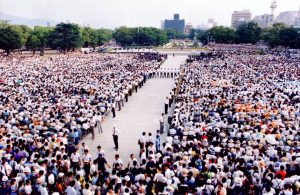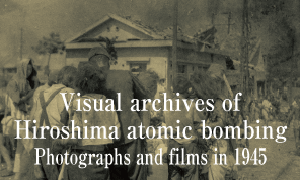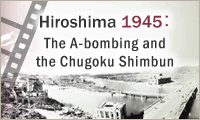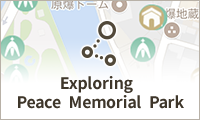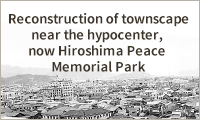Documenting Hiroshima 80 years after A-bombing: On August 6, 1995, Peace Memorial Ceremony calls out inhumane nature of atomic bombs
May 18, 2025
by Kyosuke Mizukawa, Senior Staff Writer
On August 6 1995, 50 years after the atomic bombing, Hiroshima City’s Peace Memorial Ceremony was held at Peace Memorial Park, located in the city’s Naka Ward. A record- number of approximately 60,000 people attended the ceremony, which was covered by 95 media organizations from 21 nations around the world, according to Hiroshima City government records alone. Herein, the Chugoku Shimbun takes a look at the city half a century after the atomic bomb was dropped by the U.S. military, turning the entire area into a scorched ruins and claiming the lives of an estimated 140,000 people (with a margin of error of ± 10,000) by the end of 1945.
In November 1945, the population of Hiroshima was around 130,000 people, a number that exceeded one million in 1985. In 1994, Hiroshima hosted the Asian Games. However, damages wrought by the atomic bombing remained, including increases in cancer incidence from radiation’s effects, with initiatives continuing to convey the reality of the atomic bombing through testimonies of A-bombing experiences and other relevant materials.
In his Peace Declaration delivered at the ceremony, Hiroshima City Mayor Takashi Hiraoka emphasized how Hiroshima’s citizens had informed the world of the “human tragedy brought about by the atomic bombs” and consistently called for the abolition of nuclear weapons. Mr. Hiraoka stated, “It is profoundly saddening that some people see the possession of nuclear weapons as symbolic of a nation’s strength. Atomic bombs are clearly inhumane weapons in obvious violation of international law.” As of 1995, although reduced from its peak, the number of nuclear weapons throughout the world was still estimated to exceed 30,000 warheads.
Non-governmental organizations such as the International Association of Lawyers Against Nuclear Arms (IALANA) engaged in the World Court Project, an effort to realize the abolition of nuclear weapons from the perspective of international law. Non-nuclear nations aligned themselves with the project. In December 1994, the United Nations General Assembly adopted a resolution requesting an advisory opinion from the International Court of Justice (ICJ) in The Hague, the Netherlands regarding whether the threat or use of nuclear weapons was lawful or unlawful.
Legal professionals and A-bomb survivors in Hiroshima staged a campaign to communicate the reality of the atomic bombing to the ICJ to elicit a judgment that the weapons were unlawful. The aim was to have oral statements made by Mr. Hiraoka and Nagasaki City Mayor Iccho Ito at the ICJ. The two mayors had the opportunity to stand in court on November 7, approximately three months after the Peace Memorial Ceremony.
(Originally published on May 18, 2025)
On August 6 1995, 50 years after the atomic bombing, Hiroshima City’s Peace Memorial Ceremony was held at Peace Memorial Park, located in the city’s Naka Ward. A record- number of approximately 60,000 people attended the ceremony, which was covered by 95 media organizations from 21 nations around the world, according to Hiroshima City government records alone. Herein, the Chugoku Shimbun takes a look at the city half a century after the atomic bomb was dropped by the U.S. military, turning the entire area into a scorched ruins and claiming the lives of an estimated 140,000 people (with a margin of error of ± 10,000) by the end of 1945.
In November 1945, the population of Hiroshima was around 130,000 people, a number that exceeded one million in 1985. In 1994, Hiroshima hosted the Asian Games. However, damages wrought by the atomic bombing remained, including increases in cancer incidence from radiation’s effects, with initiatives continuing to convey the reality of the atomic bombing through testimonies of A-bombing experiences and other relevant materials.
In his Peace Declaration delivered at the ceremony, Hiroshima City Mayor Takashi Hiraoka emphasized how Hiroshima’s citizens had informed the world of the “human tragedy brought about by the atomic bombs” and consistently called for the abolition of nuclear weapons. Mr. Hiraoka stated, “It is profoundly saddening that some people see the possession of nuclear weapons as symbolic of a nation’s strength. Atomic bombs are clearly inhumane weapons in obvious violation of international law.” As of 1995, although reduced from its peak, the number of nuclear weapons throughout the world was still estimated to exceed 30,000 warheads.
Non-governmental organizations such as the International Association of Lawyers Against Nuclear Arms (IALANA) engaged in the World Court Project, an effort to realize the abolition of nuclear weapons from the perspective of international law. Non-nuclear nations aligned themselves with the project. In December 1994, the United Nations General Assembly adopted a resolution requesting an advisory opinion from the International Court of Justice (ICJ) in The Hague, the Netherlands regarding whether the threat or use of nuclear weapons was lawful or unlawful.
Legal professionals and A-bomb survivors in Hiroshima staged a campaign to communicate the reality of the atomic bombing to the ICJ to elicit a judgment that the weapons were unlawful. The aim was to have oral statements made by Mr. Hiraoka and Nagasaki City Mayor Iccho Ito at the ICJ. The two mayors had the opportunity to stand in court on November 7, approximately three months after the Peace Memorial Ceremony.
(Originally published on May 18, 2025)

